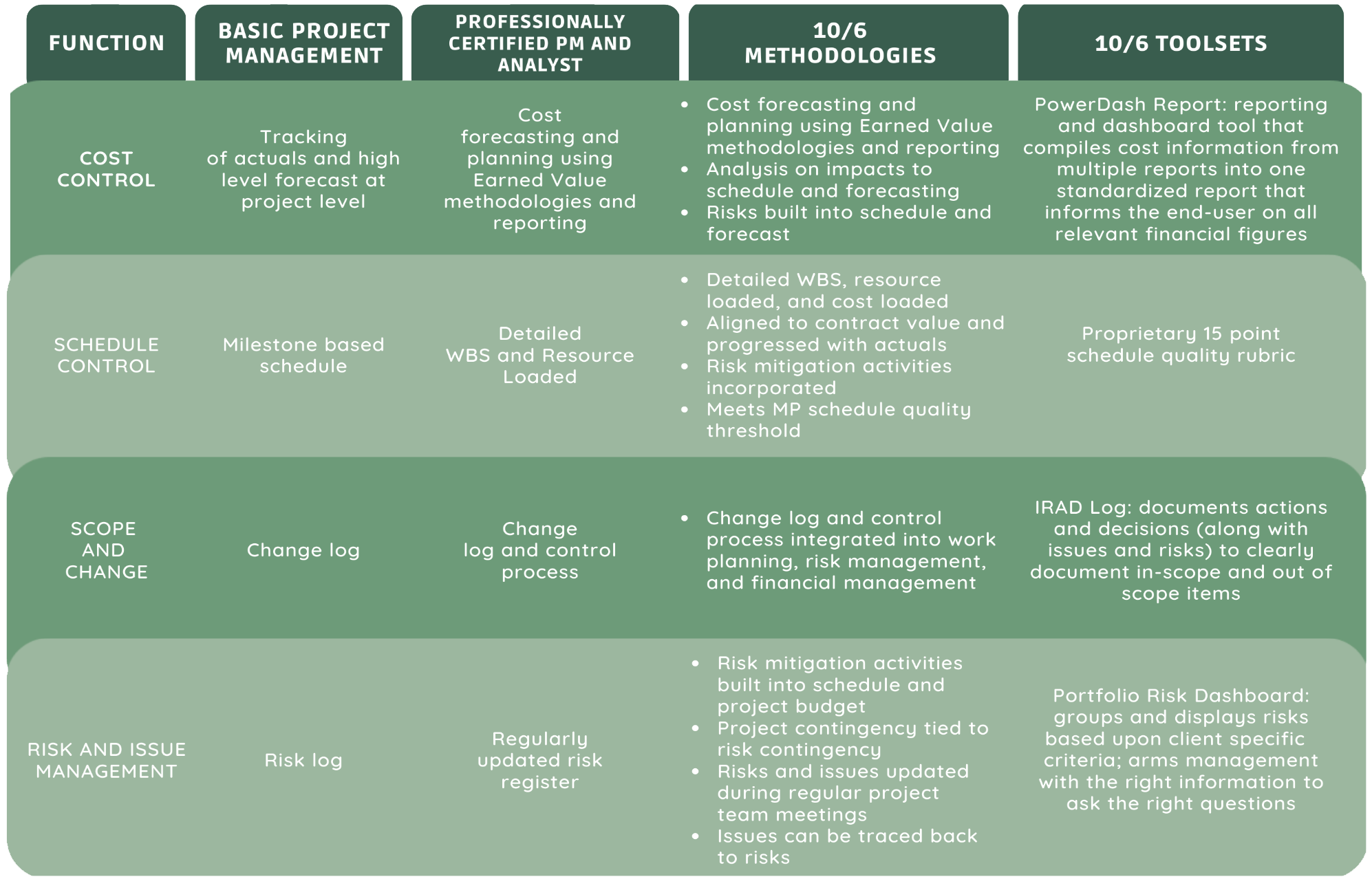Capabilities
Expertise That Matters. Solutions That Deliver Results.
At 10/6 Professional Services, we’re fueled by a passion for excellence and sustainability. At our core, we’re passionate problem solvers who thrive on complex challenges, delivering positively impactful capital projects to transform the world into a more sustainable place.
Our team of experts consistently delivers exceptional results, going above and beyond to exceed client expectations. With sustainability considerations at the forefront of every project we take on, we’re committed to making a positive impact on the world around us.
What we do
- Project Management
- Program Management
- Project Controls
- Project Scheduling
- Portfolio Management
Project Success
- Under 5% forecast variance
- Zero safety incidents
- In-Service Dates met
Qualifications
- PMI PMPs
- AACE Schedule Technicians
- Primavera P6 Specialists
- Microsoft Project Technicians
- Oracle Unifier Technician
- …and many more
PROJECT MANAGEMENT




PROJECT CONTROLS




Our Approach


Transmission Line (T-Line) Capital Project
When it comes to powering your project during a planned clearance, generators can quickly rack up costs of over $10k per day. That’s why our project managers (PMs) prioritize safety and cost-effectiveness to provide our clients with the best possible service. We explore opportunities for pre-clearance work and consider pre-fabricating or partially constructing equipment to minimize costs and reduce the clearance window.
More...
We believe that strong communication lines are crucial to managing the generation effort efficiently and ensuring that your project is completed on time.
Recently, we worked on a challenging electric distribution pole replacement project in the foothills. The project required temporary generation at the same two substations as our client’s project, scheduled for early 2018. Rather than work separately, we recognized the opportunity for collaboration and coordination with the other project team.
While there was a slight risk of delay due to drilling difficulties, our PM’s schedule adjustment resulted in over $1M in cost savings by completing the work in the Fall of 2018 and sharing the cost of temporary generation and construction crews.
At 10/6 Professional Services, we don’t just manage projects – we go above and beyond to provide exceptional service and innovative solutions. We take pride in helping our clients achieve their goals and save money in the process.

T-Line Supervisory Control and Data Acquisition (SCADA) Program Management
More...
Using our expertise in automation, we built reports to capture P6 schedule data from the contractor schedules and populate the metric milestones per region. Our Scheduler and PCA also integrated resource management and tracking tools into the report. They created engineering and construction dashboards utilizing the contractor P6 schedules to summarize month-over-month data for each Engineering, Procurement, and Construction (EPC) vendor for the PG&E key milestones.
The results were staggering – decreased human performance errors and major cost savings through the automation of manual reporting. We know that avoiding manual reporting at the earliest possible program stage is key to keeping costs down. For instance, before our team stepped in, each EPC contractor spent two hours per week on average generating engineering updates manually, with the Utility spending another four hours per week manually capturing those updates and combining them all under an Excel sheet. Over the course of one year, that’s 520 hours of wasted time and money.
But with our automation efforts, we saved $110K per year for engineering reporting alone – just imagine the savings from automating all the reports and data requests needed daily! At 10/6, we believe in working smarter, not harder. Let us show you how we can help your project run more efficiently and cost-effectively.
